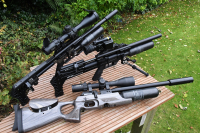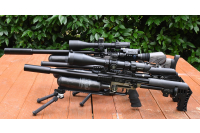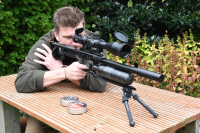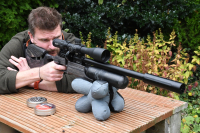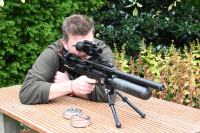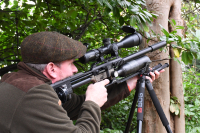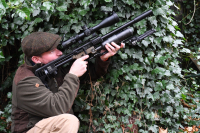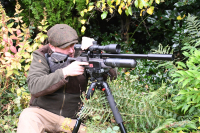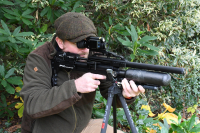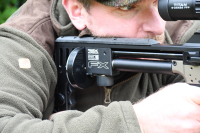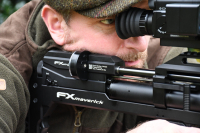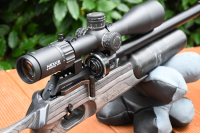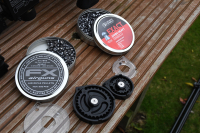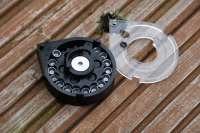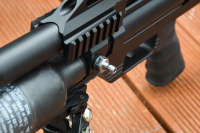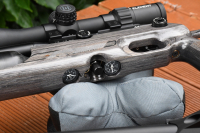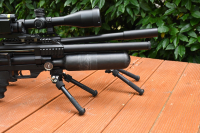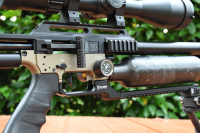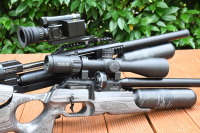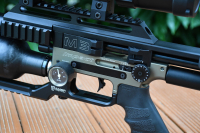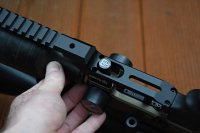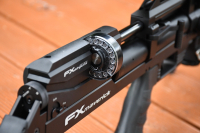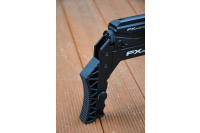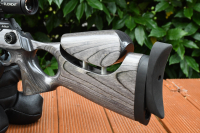By Chris Parkin
Trying to sum up the capabilities and variation across the FX range in one short article is an almost impossible task but I can quite understand why the Crown Mk II, Impact M3 and Maverick are at the forefront.
My experience with Impact Mk II last year drew me into the world of airgun tuning and in FAC format, this rifle was a superb performer with amazing versatility to accurise the air pressure system not only for appropriate power levels, but to optimise the blast of pressurised air for alternate projectile weights. If I had gone down the route of barrel/calibre change, the world was seemingly my oyster. When the M3 became available in 2021, I decided to run three similar FX rifles side by side, but this time all in UK specific sub 12 ft-lb power level and .22 calibre to get a good side by side comparison. I wasn’t focussed so much on comparing specific precision and accuracy, more on the ergonomic variations on offer to suit users’ needs.
The M3 in its bullpup format, is perhaps the king of the FX range, large volume 28 round magazine in .22 with likely 300-400 round shot count from the 250 Bar fill pressure. Stating statistics is difficult as depending on barrel length and cylinder volume, all can vary slightly, yet FX’s comprehensive website seems to offer data that is believable in the real world depending on your choices. Handling character is rearward weighted with a high vertical profile to the rifle with possibility to rest using the buddy bottle or with an extended underside Saber Tactical Picatinny rail for bipod. The carbon fibre bottles don’t draw the heat from your supporting hand like aluminium will although with a full aluminium chassis layout, the rifle is always going to be comparatively cold to hold without gloves in winter. I chose bronze colouration as I like a little contrast from just black and the looks will always polarise opinion, yet this is a rifle idealised for mechanical perfection and superior airflow through the regulators for accurate performance. The new shorter side cocking lever is most definitely lighter to operate and with a short throw, extremely fast in operation. Left handers are now assisted by the possibility of swapping this lever to the left side of the gun although magazine must remain to the right side of the rifle. Although large, this doesn’t seem to interfere with cheek or chest position in close proximity to the rifle other than with heavy jackets or rucksack. Plentiful lateral picatinny rail offer mounting positions for accessories and the upper 20 M.O.A. rail provides plentiful scope mounting linear space and range boosting elevation. This is perhaps more applicable to FAC versions and slug shooters yet it never harms a sub 12.
Zeroed on paper at 25 metres, I tried a wide range of pellets yet for internal, external and terminal ballistic effect, I relied upon JSB Diablo Heavies at 18.1gr in all three rifles. These feed from their mags without point damage and in day-to-day terms, offer me the most pellet to physically get hold of in my fingertips when loading the sprung carousel magazines without fumbling. Ultra-heavies in the 25gr range were too loopy at 12 ft-lbs to get the best multi range use for pest control and the lighter 15gr pellets were a little less consistent on paper, where I find the Smooth twist barrels preferred the Heavies. No sling anchor studs are provided (on any of the rifles) so you have to improvise a little although the rubbersied underslung grip is always assured and tactile, never cold in the hands. The trigger offers adjustability with crisp two stage pulls and when fired, minimal action noise is discernible within except for a low “shhhh” as the air refills the plenum below. The new pressure gauges offer better visibility and the Foster filling adaptor below is well recessed and protected from damage ahead of the trigger guard. A small 90-degree lever safety catch provides an audible, soft click that just advertises relentless mechanical perfection within from its sprung detents.
When it came to hunting, the effectively shrouded barrel with replaceable liner and little wasted air was already minimal for noise and the ability to add an additional moderator makes this gun even quieter in use, especially noticeable within resonant echoing barns. Being sub-12, the left side power adjuster only goes DOWN from 12-ft-lbs and although you can see machined recesses for the missing micro adjuster (found only in FAC format), but on the other hand, will many airgun shooters want to venture below 12 ft-lbs for hunting, other than in very close confines with delicate backstops? Of course, a Picatinny rail allowed me to swap to night vision use without problems and gain correct eye relief without strain, the butt pad offers 20mm of vertical adjustability, grips your shoulder well and features frontal finger grooves for additional grip if pushed into your shoulder with off trigger hand.
The M3 is definitely a tuner’s rifle and although functional for hunting, shows significant benefits offering short bullpup length and large shot count at the expense of tall vertical height above the supporting hold so watch out for CANTING the higher centre of gravity rifle. It is a mechanical delight in terms of accuracy and precision, both as a rifle projecting a pellet and in its own inherent engineered form, the care and maintenance and tuning of which will be a hobby in its own right for some shooters. Particular areas to watch for are the cocking slider which runs smoothly but exposes greased surfaces that will attract dust and need keeping clean.
The Crown Mk II offers great contrast to the M3, ballistically similar but looks and ergonomics wise, a vast departure. Using the same 480ml Carbon fibre buddy bottle, this rifle grows to 860mm overall length (not including moderators) compared to the M3’s 735mm. weight at 3.1kg is similar but the balance point of the rifle alters, as does it’s vertical profile, now much lower centre of gravity so feels more laterally stable in the hands. The Laminate stock, available in alternate colours is a delight to handle with vertical and laterally adjustable cheekpiece, and recoil pad to really tailor it to you, the shooter. In contrast with It’s more mechanical sibling, the Crown feels more organic and less machine like. The similar side lever cocking shows a more slender handle, still fingertip light but due to a more direct layout with fewer levers and linkages inherent to a bullpup format, you eliminate miniscule, multiple tolerances present in a more complex mechanism for an almost undefinable, yet still present tighter feel to operation, both when cocking and loading the rifle. The trigger system too feels slightly more direct. The right side 90-degree safety catch swings slightly proud of the stock’s right side above the trigger and small chequered panels reside on forend and grip, the two main contact points for assured security. Twin tuning dials on the stock’s left side control power but yet gain, at sub 12, less likely to see as much experimentation due to their legal limitations compared to FAC. Nearly all of my shooting is at ground level or with solid backstops so I rarely ever lower power unless on very close shots within barns, shooting upwards on feral pigeons, lowering power changes zeroes and overall trajectory shape so needs taking into account.
Like all FX’s, machining and anodising standards are peerless yet somehow, more visible here as a contrast in looks to the laminate stock. 20 M.O.A. Picatinny rail requires mount height to be factored around the scope’s tube and saddle needing to clear the sprung carousel 18 shot (in 22) magazine that slides up underneath it from the right side. Magazine/action location makes the Crown more conventional in looks like a sporting rifle but mid rail like this, may affect some night vision scopes that rely on a longer mounting footprint remaining uninterrupted. Accuracy on target was hard to differentiate in the real world from the M3, I personally preferred the slightly longer, lower rifle profile in its laminate stock as it’s more akin to my usual shooting requirements, positional setup and all my other rifles yet read on, as my mind may change. Again, the Smooth twist X superior liners can be changed with broad range of calibres and barrel lengths subject to power specification. Fill pressure through the well protected Foster adaptor is 250 Bar and easily accessible on the underside with air bottle (removable) and regulator pressure Manometers offering tracked performance of shot counts listed and no surprise running out of air suddenly.
My initial thoughts were the Crown would be my favourite but third guest to my party was the Maverick. This is a significantly cheaper rifle and the first FX to have offered twin regulators when first released, shooting from the bench at 25 metres showed it’s identical barrel, air bottle and design ethos to show slight lead over that of the more expensive brothers above it. That’s not to say there isn’t slight compromise though, we return back to the bullpup layout and the magazine is still on the right side and being higher up under the comb than that of the M3, even though it’s smaller, does preclude left-handed use. The smaller 18 round mag (in 22) is identical to the Crown’s and seems a great compromise for realistic compact size with ample capacity when hunting. How many shots do you want before refilling a magazine? I prefer the slightly more compact feel personally. You could say the same for ultimate shot count, the Maverick would happily cycle ten magazines (180 pellets) before I was even tempted to return home and top up. For target shooters travelling to the range, ultimate shot count may be more critical but for hunters, 180 shots is either a very busy successful evening or something went critically wrong, which thankfully, wasn’t the case for me with the Maverick. This rifle was my preference to mount night vision on, again a 20 M.O.A. rail is offered and like all the rest, the gun slots most easily into it’s spacious supplied case for transit, the M3 and crown have custom fit foam liners than need adjusting once your scope is fitted. All three use sprung carousel magazines of similar design and other than volume, equally capable performance. It’s important to keep them clean, disassembly is not too difficult and once done the first time, nothing too worrisome, similarly magazine tension can be altered.
I think to sum up, based on looks alone, the Impact and Crown will polarise shooters 50:50 yet the M3 runs ahead technically, especially in FAC format for which I think FX are most adaptable, especially when you want to venture into larger calibres and slug usage. In terms of purity, economy, accuracy and reliability, the Maverick left its mark on me as the most integrated package to suit all uses, no less enjoyable to shoot yet a little more focussed with only a single power adjuster to tempt shooters wanting to drop below 12 ft-lbs for specific scenarios. I think the only place the Maverick seemed a little dated was the side position of the Foster fill adaptor, standing proud from the left side of the gun, it’s easily accessed but possibly more likely damaged though? For left handers, the Crown offer least magazine intrusion into the ergonomics with the most versatile stock layout yet the M3 offers that left-handed cocking lever adaptability. After shooting all three for as many months, I find it hard to choose just one but for my only occasional left-handed use, I would go with the Maverick for compact bullpup hutting needs with a bipod option. If I was going FAC, definitely the M3 where tuning capability is a hobby in itself offering so much more versatility. For the purist, the Crown still merges traditional layout with modern design cues to the materials and of the three, other than not being a shorter bullpup, gives the most stock versatility. The choice really is yours, but I can’t say any were lacking in accuracy or functional perfection.
Photo Captions
- All three brothers in arms
- Overall length comparison
- The M3 shows most adjustability for tuning
- The Crown shows most conventional layout
- The Maverick is extremely compact and most functionally pure
- M3 balance and compact nature are superb when hunting
- M3 Especially good when shooting off-hand
- The Crown is the most suited to a gun clamp, but the others can use Picatinny adaptors
- For night vision, the Maverick seemed to fit the bill best for me
- Larger, lower mag on the M3 won’t obscure left-handed use
- Smaller, but higher mag position on the Maverick would be more limiting for a left hander
- Central magazine position on the Crown requires care when choosing scope mounts
- All three use similar sprung carousel type magazines, strip down and maintenance is fairly straightforward
- Magazine detail
- Left side Foster connector stands proud on the Maverick
- Whereas the crown and M3 shield the Foster underneath
- Saber Picatinny rail on the M3 offers more stability from longer `wheelbase` on the rifle
- The new shorter side lever on the M3 is blisteringly fast to cycle the action and can be swapped to the left side
- Here you can see the scope mounting difference between Crown and Maverick
- This non-FAC M3 still shows architecture for the additional tuning elements present on FAC versions
- Saber Tactical Picatinny extension shield the Foster adaptor securely
- Magazine system close up, remaining pellets easy to see!
- The Maverick is perhaps the most `pure` with just a single simple power adjuster and vertically adjustable recoil pad
- The Crown offers greatest recoil pad and cheekpiece adjustability for shooter comfort and repeatable gun mount

